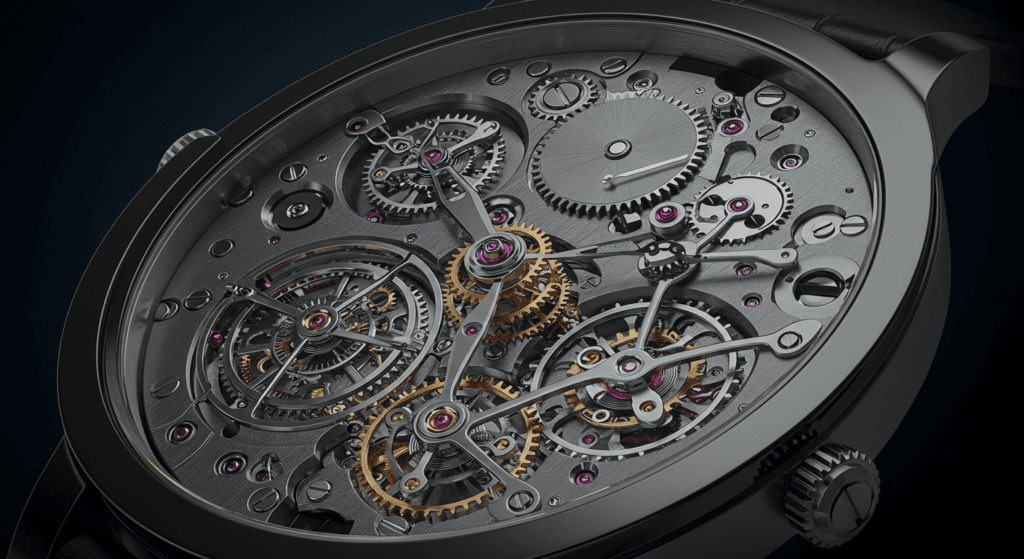The tourbillon, a mesmerizing complication in the world of horology, is more than just a mechanism—it’s an embodiment of craftsmanship, innovation, and artistry. First invented by Abraham-Louis Breguet in 1801 to counteract the effects of gravity on pocket watches, this intricate device has evolved over centuries into one of the most coveted features in luxury timepieces today. In this article, we’ll explore the history, mechanics, and allure of the tourbillon, shedding light on why it remains a symbol of excellence in watchmaking.
A Brief History of the Tourbillon

The story of the tourbillon begins in the late 18th century when Abraham-Louis Breguet, a Swiss-French watchmaker renowned for his ingenuity, sought to improve the accuracy of pocket watches. At the time, these timepieces were predominantly carried vertically in pockets, causing gravitational pull to affect their balance wheels and escapements, leading to inaccuracies.
Breguet’s solution was ingenious: he designed a rotating cage that housed the escapement and balance wheel, allowing them to continuously change position as the watch moved. This constant rotation neutralized the impact of gravity, significantly improving precision. Though originally intended for practical purposes, the tourbillon soon became a testament to the artistry of watchmaking.
By the mid-20th century, with the advent of wristwatches and advancements in technology, the need for a tourbillon diminished due to the varied positions wristwatches naturally assume throughout the day. However, its aesthetic appeal and complexity ensured its survival, transforming it from a functional necessity to a luxurious display of skill.
How Does a Tourbillon Work?

At its core, a tourbillon is a mechanical marvel. It consists of a rotating cage that houses the escapement and balance wheel. Here’s how it operates:
- Rotation: The entire assembly rotates around its axis, typically once per minute (though some modern variations rotate faster).
- Gravity Neutralization: By constantly changing the orientation of the sensitive parts, the tourbillon minimizes the negative effects of gravity.
- Precision: While not strictly necessary in today’s wristwatches, the tourbillon still serves as a benchmark for exceptional engineering.
Creating a tourbillon requires unparalleled expertise. Its components are minuscule yet precise, often hand-assembled by skilled artisans. A single tourbillon can contain over 60 individual parts, all working in harmony within a space no larger than a few millimeters.
Types of Tourbillons
Over the years, watchmakers have pushed the boundaries of what a tourbillon can achieve, resulting in several fascinating variations:
Traditional Single-Axis Tourbillon
This is the classic design introduced by Breguet, where the cage rotates along a single axis. It remains popular among purists who appreciate its simplicity and elegance.
Dual-Axis and Multi-Axis Tourbillons

For added complexity, some manufacturers create multi-axis tourbillons, which rotate along two or more axes simultaneously. These designs are often seen in high-end luxury watches and showcase advanced engineering capabilities.
Flying Tourbillon

Unlike traditional tourbillons, flying tourbillons lack a supporting bridge at the top, giving them a “floating” appearance. This design enhances visibility and highlights the delicate mechanics inside.
Carrousel vs. Tourbillon
While similar in purpose, the carrousel differs slightly in construction and function. Both mechanisms aim to combat gravity but use different approaches, making each unique in its own right.
Why Collectors Love Tourbillons

For many enthusiasts, owning a tourbillon is akin to possessing a piece of living history. Below are some reasons why tourbillons continue to captivate collectors:
- Artistic Expression: Each tourbillon is a miniature masterpiece, showcasing the creativity and technical prowess of its creator.
- Symbol of Luxury: Watches featuring tourbillons often come from prestigious brands like Patek Philippe, Vacheron Constantin, and Rolex, commanding high prices and status.
- Visual Appeal: With transparent dials and skeletonized designs, modern tourbillons allow wearers to admire the movement in action, creating a hypnotic visual experience.
- Investment Potential: Due to their rarity and craftsmanship, tourbillon-equipped watches frequently appreciate in value over time.
Modern Innovations in Tourbillon Technology

Today’s watchmakers are reimagining the tourbillon with cutting-edge technologies and materials. For instance:
- Silicon Components: Lightweight and resistant to magnetism, silicon reduces friction and enhances performance.
- Carbon Fiber Cages: Some brands experiment with carbon fiber to lighten the load, improving efficiency without sacrificing strength.
- Smart Integration: High-tech brands incorporate tourbillons into connected watches, blending tradition with innovation.
These advancements ensure that the tourbillon remains relevant in an era dominated by smart devices and digital displays.
Iconic Tourbillon Watches

Certain models stand out as benchmarks in the realm of tourbillon watches. Here are a few notable examples:
Patek Philippe Nautilus Tourbillon
Combining sporty elegance with groundbreaking technology, this model redefines luxury for active individuals.
Vacheron Constantin Les Cabinotiers Celestia
Featuring 23 complications, including a triple-axis tourbillon, this masterpiece represents the pinnacle of horological achievement.
Greubel Forsey Quadruple Tourbillon
With four independently rotating cages, this watch exemplifies extreme complexity and innovation.
Richard Mille RM 027 Rafael Nadal
Designed for professional athletes, this lightweight tourbillon withstands intense physical activity while maintaining impeccable accuracy.
Conclusion
From its humble origins as a solution to a practical problem to its current status as a symbol of prestige, the tourbillon has traversed an extraordinary journey through time. Whether you’re drawn to its historical significance, mechanical brilliance, or sheer beauty, there’s no denying the allure of this iconic complication. As watchmakers continue to innovate, the tourbillon will undoubtedly remain a cornerstone of luxury horology, inspiring awe and admiration for generations to come.
Are you ready to explore the world of tourbillons? Discover our curated selection of exquisite timepieces featuring this dramatic complication. Visit our website or contact us to learn more about acquiring your very own piece of horological history.







1 thought on “Tourbillons Through Time: The Evolution and Allure of Watchmaking’s Most Dramatic Complication”